- Joined
- Jan 17, 2013
- Messages
- 27
- Points
- 0
Hello guys, I'm new to these forums. I built a laser a few days ago using an LPC 826 in an aixiz module from hightechdealz.com. I made the DDL driver circuit to test it out, and it was working okay. I hate using a breadboard to do testing, so I decided to use a professional current source to simply select the current I wanted instead of using the 1.25V/R method.
I set the current to 100mA and the beam spot showed up on the wall and I focused it down to the tightest spot I could. Then I slowly increased it, and the spot got brighter up to about 200mA. After that, an increase in current doesn't produce any significant jump in brightness, even up to 400/500 mA.
Now what I'm mainly concerned about is not the brightness of the beam at the end of the path, but the brightness of the path itself. I want to use this for astronomy. It helps so much to be able to point to a star or planet with the beam apparently traveling on to infinity.
But even in the dark, there's no beam path, just a spot on the wall. I understand the chromatic response of the human eye, that the sensitivity of the eye to green is much greater than that of red or violet, but it seems odd that a laser driven to 300mW using 500mA appears dimmer than a 5mW green laser, and lacks a beam path. It seems like a lot of amateur laser builders are also concerned with heat sinking the diode, but even when being driven at a high current, the diode never got more than lukewarm, the same thing goes for the LM317. Also, even when being driven at .5A, it wouldn't light a match.
I'd appreciate any feedback you guys have.
I set the current to 100mA and the beam spot showed up on the wall and I focused it down to the tightest spot I could. Then I slowly increased it, and the spot got brighter up to about 200mA. After that, an increase in current doesn't produce any significant jump in brightness, even up to 400/500 mA.
Now what I'm mainly concerned about is not the brightness of the beam at the end of the path, but the brightness of the path itself. I want to use this for astronomy. It helps so much to be able to point to a star or planet with the beam apparently traveling on to infinity.
But even in the dark, there's no beam path, just a spot on the wall. I understand the chromatic response of the human eye, that the sensitivity of the eye to green is much greater than that of red or violet, but it seems odd that a laser driven to 300mW using 500mA appears dimmer than a 5mW green laser, and lacks a beam path. It seems like a lot of amateur laser builders are also concerned with heat sinking the diode, but even when being driven at a high current, the diode never got more than lukewarm, the same thing goes for the LM317. Also, even when being driven at .5A, it wouldn't light a match.
I'd appreciate any feedback you guys have.






